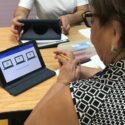
That same semester, GED in Spanish was piloting a blended learning program that provided students with loaned tablets and data. “I thought that I would lose my semester,” said Alexa. “But with the tablet, I was able to do my homework and study from my bed. I was able to pass the test and graduate.”
For the past two years, various programs at the school have integrated blended learning components to their classes, combining online activities with face to face instruction. Thanks to supportive organizations such as UnidosUS and OSSE’s SOAR grant, the School is able to lend devices with data plans to students who may not otherwise have access to these technologies at home.
The ESL for Families program, which offers specialized content English classes in different schools in D.C., was the pioneer in this effort. In their pilot in Spring 2017, forty students received tablets, thanks to a partnership with English Innovations. At the end of the pilot, students averaged 16 additional hours of learning through use of their tablets. Most recently, during the Fall 2018 semester, students averaged approximately 30 additional hours of class time through their device use.
One student, Yilfsahowa, used her tablet to read with her elementary school daughter. During a parent-teacher conference, her daughter’s teacher said that she had improved her reading, partially thanks to them reading together.
For the GED in Spanish program, providing students with technology outside of the school is important given the GED Testing Service’s requirement that tests are taken in computers. Students are able to use their devices to access homework and practice tests, and improve their reading comprehension and essay writing.
“We have seen an increase in attendance after starting this program,” said Sandra González, Director of the GED in Spanish Program. “Studies have shown that the higher the level of involvement of students, the higher their persistence. Using these technologies has been a big part of that.”
Another class doing blended learning is Citizenship, which is offered once a week in preparation for the Citizenship exam. Students can access supplemental materials and interactive activities that help them learn about U.S. government and history, understand vocabulary important for their citizenship applications, and practice interview skills.
Currently, the school is piloting an additional program, targeted at potential students who were placed in waiting lists or who could not attend full time classes. English Now! Learning Circles for English Language Learners is a project of World Education’s EdTech Center in partnership with Carlos Rosario School, funded by Dollar General Literacy Foundation. Through this class, students are able to come to the school once a week and continue the rest of their learning online using USA learns and a laptop with data provided by the school.
“It’s all about reinforcement and repetition, and providing learners choice in a structured way,” said Heather Ritchie, Professional Development Specialist. “Blended learning gives students the ability to direct their learning and do it in their own time.”
